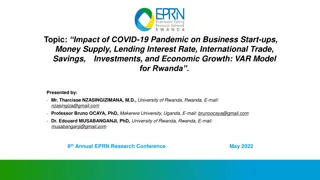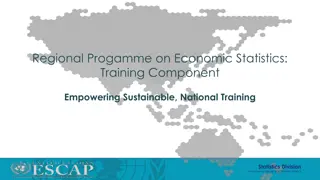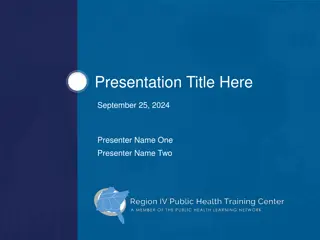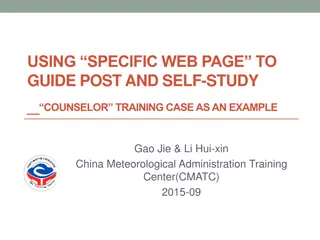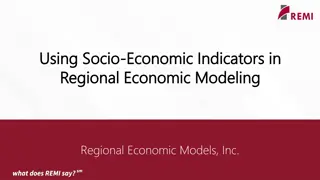Economic Impact Analysis of Yakima Training Center
Yakima Training Center (YTC) plays a significant role in the economic landscape of Yakima County, serving as a major employer with substantial annual payroll. The YTC's operations, including construction expenditures and other expenses, have direct, indirect, and induced impacts on the local economy. Through the application of economic impact methodology and multiplier analysis, the report assesses the effects of YTC activities on employment, output, and income in Yakima County.
Download Presentation

Please find below an Image/Link to download the presentation.
The content on the website is provided AS IS for your information and personal use only. It may not be sold, licensed, or shared on other websites without obtaining consent from the author.If you encounter any issues during the download, it is possible that the publisher has removed the file from their server.
You are allowed to download the files provided on this website for personal or commercial use, subject to the condition that they are used lawfully. All files are the property of their respective owners.
The content on the website is provided AS IS for your information and personal use only. It may not be sold, licensed, or shared on other websites without obtaining consent from the author.
E N D
Presentation Transcript
Yakima Training Center Economic Impact Analysis 2018 Yakima and Central Washington Economic Symposium Dr. Charles S. Wassell, Jr. Department of Economics, CWU wassellc@cwu.edu
Yakima Training Center (YTC) Key Facts: 1. The U.S. Army originally leased 160,000 acres from 1942 to 1946. The YTC currently covers 327,000 acres about 10% of Yakima County. 2. The YTC is assigned to Joint Base Lewis-McChord 3. The YTC is the 9th largest employer in Yakima County, with approximately 850 employees and an annual payroll of ~ $26 million.
Yakima Training Center (YTC) Key Facts: 4. Average annual construction expenditures of $17.8 million. 5. Other expenditures: Food and Lodging: $966,000 Fire-fighting support: $1.27 million Fuel (JP8, Diesel, Unleaded): ~ $3.2 million Service Contracts: $2.97 million Other: $634,000
Economic Impact Methodology An increase or decrease in production and employment within a local area has a multiplier effect as other sectors of the local economy are impacted by the changes in local spending. The estimation of the multiplier effect for each sector is the objective of input-output analysis.
Three Types of Impacts Impacts from a particular event fall into three categories: direct, indirect, and induced. Direct Impact Indirect Impact Induced Impact Induced Impact Total = Direct + Indirect + Induced
Multiplier Example For every construction worker hired, employment increases an additional 0.55 workers. Multiplier = Total Impact Direct Impact e.g. (100 + 25 + 30 ) / 100 = 1.55
Yakima County Impacts Construction: YTC five-year average annual construction is $17.8 million. For this expenditure, employment, output, and income impacts on Yakima County are: Direct Indirect Induced Total Multiplier 154.6 1.57 Employment 98.5 29.3 26.7 $3,560,433 $26,156,941 1.42 Output $18,400,000 $4,196,507 $9,070,587 1.37 Labor Income $6,635,119 $1,309,952 $1,125,516
Yakima County Impacts Non-construction Impacts: employment, output, and income impacts on Yakima County are: Direct Indirect Induced Total Multiplier 349.9 1.19 Employment 294.6 7.4 48 $6,393,891 $37,814,820 1.24 Output $30,473,211 $947,718 $2,021,102 $16,637,382 1.16 Labor Income $14,331,688 $284,592
Kittitas County Impacts Kittitas County: expenditure, employment, output, and income impacts on Kittitas County are: Direct Indirect Induced Total Multiplier 10.4 1.16 Employment 9 0 1.3 $1,078,922 1.20 Output $900,000 $5,079 $173,844 $477,777 1.01 Labor Income $431,948 $1,692 $44,137
Washington State Impacts Washington State: expenditure, employment, output, and income impacts on Washington State are: Direct Indirect Induced Total Multiplier 529.4 1.63 Employment 324.9 53 151.6 $24,201,254 $87,451,365 1.64 Output $53,192,702 $10,057,409 $7,833,378 $37,713,658 1.41 Labor Income $26,688,498 $3,191,783
State and Local Taxes Create up to $3 million in state and local taxes: up to $850,000 is comprised of property taxes up to $1.73 million in sales taxes. Ambiguity because federal expenditures are not subject to state and local taxes; however, indirect and induced expenditures, at a minimum, do contribute to taxes.
Non-pecuniary Benefits Supports readiness by U.S. military forces, as well as allied forces and law enforcement. As the only place in Washington where shrub-steppe occurs on a landscape scale, the YTC also provides valuable habitat for some species, e.g. the Greater Sage Grouse.










